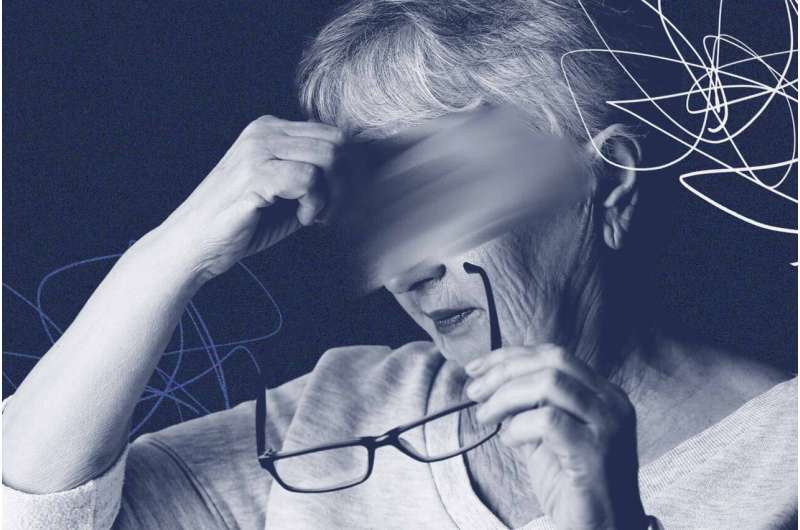This article has been reviewed according to Science X's editorial process and policies. Editors have highlighted the following attributes while ensuring the content's credibility:
fact-checked
trusted source
proofread
Neuroscientists solve mysteries about leading biomarker for Alzheimer's

University of Virginia neuroscientists have revealed how a toxic form of tau protein, notorious for forming tangles in the brains of people with Alzheimer's disease and several other neurodegenerative disorders, spreads through the brain as the disease progresses.
The tau protein helps cause cognitive decline associated with those diseases. The research shows what provokes its accumulation and how it harms nerve cells called neurons. Scientists may be able to leverage these findings to develop new Alzheimer's treatments that prevent or delay symptom onset, or slow disease progression once symptoms develop.
UVA's new research also advances efforts to develop blood tests to detect Alzheimer's at its earliest stages, when it is, in principle, most amenable to treatment. The researchers found that antibodies used in blood tests for measuring this toxic, chemically modified form of tau, called "taupT217," can easily be fooled into detecting other proteins, which compromises test accuracy. Fortunately, they also showed how this problem can be avoided.
The new research from UVA's Dr. George Bloom and collaborators is the most comprehensive examination yet of where and how taupT217 accumulates in the brain. The results provide vital insights into the development of Alzheimer's and possibly other neurological conditions called "non-Alzheimer's tauopathies." Those include Parkinson's disease and chronic traumatic encephalopathy.
"The past few years have witnessed exciting advances in early Alzheimer's detection by measuring the amount of taupT217 in blood or cerebrospinal fluid, but until now almost nothing has been learned about what causes this type of tau to form in the brain or how it affects neuron health," said Bloom, of UVA's Departments of Biology, Cell Biology and Neuroscience, as well as the UVA Brain Institute, the Virginia Alzheimer's Disease Center and UVA's Program in Fundamental Neuroscience.
"Knowing what provokes taupT217 to build up in the brain and how it harms neurons provides new openings for therapeutic intervention," he said.
Understanding Alzheimer's
Tau plays important roles in the healthy brain, where, among other things, it helps build and maintain the "microtubules" that serve as highways for transporting important materials within the neurons that form the brain's circuitry. But in people with Alzheimer's, tau becomes chemically modified and misshapen in ways that prevent its normal functioning and make it toxic. This eventually leads to two phenomena that account for cognitive decline in Alzheimer's: destruction of neuronal circuitry and neuron death.
Why this occurs has been only partially understood, but UVA's new research offers more answers. For example, the researchers found that they could trigger taupT217 buildup inside cultured neurons by exposing them to clusters, or oligomers, of tau. Those are known to accumulate in the Alzheimer's brain and have long been suspected as a harmful contributor to the disease. They also found that the chemical modification that converts normal tau into taupT217 dramatically decreases tau's ability to stick to microtubules, which in turn may make it easier for the tau to form toxic oligomers.
"In terms of immediate clinical value, we hope that our findings about the challenge of antibody specificity for measuring taupT217 in blood will quickly resonate with companies that are striving to develop commercially available tests to identify Alzheimer's patients years before symptoms become evident," Bloom said. "Because massive irreversible brain damage has already occurred by symptom onset, accurate early diagnosis will be crucial for development of drugs that effectively combat Alzheimer's."
That's just one example of the practical insights generated by UVA's research that will benefit the efforts to better diagnose and treat Alzheimer's.
"Alzheimer's disease reflects a multi-dimensional breakdown of normal brain cells, so there is nothing simple about it," Bloom said. "Focusing research on the earliest processes that convert normal brains into Alzheimer's brains, though, provides the best hope for eventually conquering this terrible disease."
The researchers have published their findings in the journal Alzheimer's & Dementia. The first author of the paper is Binita Rajbanshi, a recently graduated pharmacology Ph.D. student. The other team members were Anuj Guruacharya, James Mandell and Bloom. The scientists reported that they have no financial interests in the work.
More information: Binita Rajbanshi et al, Localization, induction, and cellular effects of tau phosphorylated at threonine 217 1, Alzheimer's & Dementia (2023). DOI: 10.1002/alz.12892




















